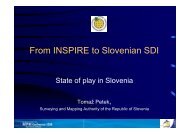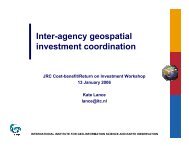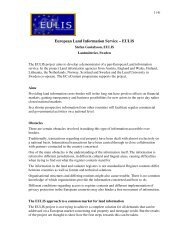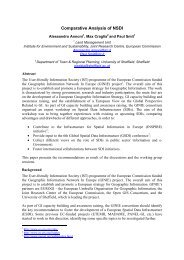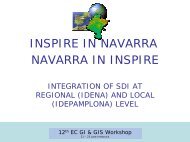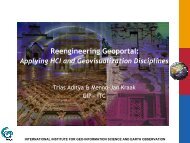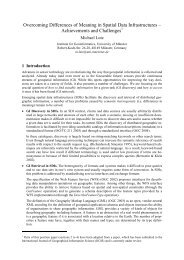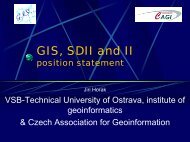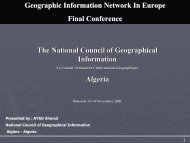session - EC GI & GIS Portal
session - EC GI & GIS Portal
session - EC GI & GIS Portal
You also want an ePaper? Increase the reach of your titles
YUMPU automatically turns print PDFs into web optimized ePapers that Google loves.
SESSION: NATIONAL SDI II<br />
Social and economic benefits from compiling the Forest Data Bank<br />
Project (Dasologio) in Greece<br />
D.S. Palaskas, N.I. Stamou<br />
1 Forester, Msc, Thessaloniki, Greece<br />
2 Professor, Faculty of Forestry and Natural Environment, Thessaloniki, Greece<br />
The lack of cadastre and validated forest maps in Greece have formed a peculiar legal status of forest and<br />
natural environment protection which relies on as the case may be certificates issuing (Characterization Acts)<br />
from Forest Authorities, a temporary procedure according to the Greek Law 998/79 but still persisting until<br />
today, although judged as constitutionally dubious from the Supreme Court of Cassation from year 1997. This<br />
rather time – consuming procedure creates additional real and bureaucracy load both for Forest Services and<br />
citizens. As a result the citizens get involved in continuous conflicts with the State and this fact becomes<br />
subject of abuse from both sides either for claiming public forest areas, either for canvass reasons respectively.<br />
Moreover, the State trying to cover weakness in other sectors relevant with planning and implementing<br />
development programs, due to the lack of general and special zoning plans, accuses the Forest Service of being<br />
too strict at the protection of natural wealth. These phenomena will probably vanish definitely with Forest Data<br />
Bank Project (Dasologio in Greek) compiling, a constitutional order already from 1997.<br />
“Dasologio” is a dynamic forest land data bank where the protected from forest legislation areas are registered<br />
(mapped) and classified according to their characteristics and their functions. Its data integration in public<br />
spatial information infrastructures will not only serve the principle of publicity but also render accessible<br />
particularly useful environmental information for the citizens and the involved authorities. The oncoming<br />
benefits are very important and assessed in thousands of man-hours yearly: a numerous scientific personnel<br />
will undertake again substantial tasks in forest management and forest development projects, the juridical load<br />
will decrease effectively and finally the practitioners’ networks living from bureaucracy load (engineers,<br />
lawyers, foresters, surveyors etc) will lack existence reasons.<br />
In Greece, two mapping projects have been implemented or are at the phase of proclamation by OSDE<br />
(Integrated System for Management and Control) and National Cadastre (ortho-basemaps production for the<br />
whole country), while exists already coverage from orthophoto maps in scale 1:5,000 and 1:20,000 of<br />
Surveying and Forest Service, respectively. On the latter, there has been made from decades and is continued<br />
until nowadays the mapping – classification according to forest species, foliage density and woodstock class,<br />
but these data, although being a good background and a remarkable know-how source of the scientific staff, do<br />
not consider to fulfill the high accuracy standards (geometric especially) of “Dasologio”. The absence of a<br />
permanent system of periodic inventories obsoletes and scorns this work as a credible forest data source. What<br />
finally connects all the mapping projects of Greek territory, though limited in area, from whichever authority<br />
or organization, is fragmentation and limited accessibility even for public authorities of the same Ministry!<br />
This (greek) phenomenon derives from distrust sensation and bad cooperation caused by confusion and<br />
dispersion of jurisdiction among the competent authorities, situation with deep roots at the competition among<br />
the scientific branches.<br />
The rapid development of new technologies (Very High Resolution satellite imagery availability, software<br />
improvement, powerful computers, web mapping) combined with political will at European Union level leads<br />
Greece to one-way, on the beginning of the new Programming Period 2007 – 2013, for the instant effectuation<br />
and integration in the developing infrastructures of a far-sighted project like “Dasologio”. The example of the<br />
projects CLC2000 and IMAGE2000 completed in only 3 years at a cost of 13 M€ (corresponding to an<br />
average cost of 3 € / ha), covering an area overcoming the today’s EU of 25 (JRC 2005) is an undeniable<br />
witness for the feasibility of the proposed venture.<br />
The convenience of elaborating “Dasologio” is supported even more if the data concerning the impacts and the<br />
benefits get quantified economically using the most popular methodology for investment choice, the Cost<br />
Benefit Analysis. One particular characteristic of this methodology is the integration of the so-called<br />
externalities, since it is obvious that the public works related with environmental protection and improvement<br />
have little economic reciprocity. This is totally true for the inventory of the national capital of forests and<br />
forest areas, unlike Cadastre which is mostly funded by the registered citizen rights. The estimates made by<br />
analyzing relevant data gathered from regional forest authorities for the last three years indicate an extremely<br />
high degree of staff occupation in the pre-mentioned temporary procedure. The total estimated cost includes<br />
40




